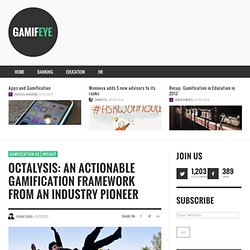

Foursquare and the Fun Gap: What Foursquare Should Have Been. Foursquare’s Lost Opportunities Today Foursquare announced a new round of debt-based financing amounting to $41M in loans and convertible notes.

It has been controversial, because debt-based financing suggests the company has a significant performance problem (Jason Gelman has a good wrap-up of the spirited discussion). Bitcoin: The First Universal Loyalty Program Currency. Will Bitcoin Revolutionize Modern Loyalty Programs?

Bitcoin — the buzzy virtual currency that’s focused on privacy — continues to gain major traction. For some time you’ve been able to pay for games (or a hitman), invest your earnings and speculate on Bitcoins. In recent days, it’s become possible to use the world’s first Bitcoin ATM and pay your employees in Bitcoins. In short, Bitcoin is angling to be the first broadly accepted virtual currency not issued by a nation-state.
Moving Beyond Points and Badges: Gamification 2.0. What’s next for gamification in the workplace?

The following is an Op-Ed by Siddesh Bhobe, CEO of eMee – a social gamification platform based in India. Motivations and Personality Types. Why do game mechanics work?

When designing game mechanics for a particular community, it is important to understand the underlying motivations and personality types that make up that community, otherwise the game mechanics may be ineffective at generating the appropriate user engagement. It all boils down to this: what some people find fun or motivating, others might not. After defining the site’s goals, the designer’s next step to building a gamified site is to understand the community’s motivations. Attitudes, interests, age, and gender demographics all play a role (as seen in the Motivations and Personality Type sections of this site). Andrzej Marczewski's Blog - Feedback Loops, Gamification and Employee Motivation. The following blog post, unless otherwise noted, was written by a member of Gamasutra’s community.

The thoughts and opinions expressed are those of the writer and not Gamasutra or its parent company. To anyone involved in game design, feedback loops will be a well known concept. To those in gamification, they are often talked about, but not everyone will know what they actually are and how they can be used. Tiny Habits w/ Dr. BJ Fogg - Behavior Change. Trigger : Search Results : Designing Behavior. Are you being played? How tech companies use gamification. This is a guest post by entrepreneur, Kris Duggan When you visit LinkedIn, one of the most ominous features encouraging profile completion is the progress bar telling you that your profile has a long way to go before you’re complete.

This very basic example of “gamification” has helped LinkedIn efficiently grow its global user base with relevant, accurate and high-value data. In simple terms, Gamification means to use game theory or game mechanics in non-game situations to manipulate and reward behavior. Social businesses have long caught on to the psychological mechanics that drive behavior. These all stem back to psychology 101, with Maslow’s Hierarchy of Needs telling us that after food, shelter, recognition and feeling accepted within a community go a long way in getting us to act one way versus another.
For instance, Facebook’s “Like” button is, in a less direct sense, a bit of a gamified experience with the motivator of this high-level human need for recognition. Behavioral engineering. Behavioral engineering is intended to identify issues associated with the interface of technology and the human operators in a system and to generate recommended design practices that consider the strengths and limitations of the human operators.

"The behavior of the individual has been shaped according to revelations of 'good conduct' never as the result of experimental study. " Watson wrote in 1924 "Behaviorism ... holds that the subject matter of human psychology is the behavior of the human being. Why does Gamification Work: A Look into Successful Examples. This is the second in a five post series into all things Gamification.

Last week, we posted ‘More Than Just Badges: We Play’s Definition of Gamification.’ The term “gamification” would not exist if it weren’t for the rise in popularity from its successful examples. We believe that the hype surrounding gamification is deserved and appropriate for the future of social media, technology, and behavioral engagement. According to Forbes, the global gaming industry is set to be worth $82bn by 2017, a considerable increase from today’s $67bn valuation. The deep engagement and connection we have with games goes beyond current scientific knowledge, but we can clearly recognize that games are powerful.
Why do we love games so much? Bunchball, Badgeville, and BigDoor are the key players in today’s gamification market. Bunchball—known to be the most professional of the three. At We Play, call us your “specialty” firm. At We Play, call us your “specialty” firm. The gamification brain trust: 6 experts on why game elements are critical in our work and social lives. Gamification, or the use of gameplay mechanics to make nongame activities more fun and engaging, has taken off in a big way.

Multiple gamification companies made appearances at Salesforce.com’s DreamForce 2012 conference this week with apps that gamify sales via leaderboards and rewards. Gamification resembles the old airline loyalty programs, but now companies can access much more data and feedback from users that can make gamification more scientific and effective. At the MIT/Stanford Venture Lab, Margaret Wallace (far left), the chief executive of Playmatics, led a discussion about gamification at the Stanford Business School in Palo Alto, Calif. How Do Habits Help Your Business? Using Neuroscience to Influence Behavior. Why Gamification is Really Powerful. The Ultimate Gamification and Game Design Toolkit. Octalysis: an Actionable Gamification Framework from an Industry Pioneer.
In the past 9 years that I have been working in Gamification (I remember the old awkward days of telling people “I specialize in making your products game-like” only to hear back, “Why would our customers want to play games?”)

, I’ve seen many attempts of Gamification that only turn out to be gimmicky, unsustainable, and simply adding no value nor ROI to products. As Gamification is becoming the hot buzzword these days, more and more agencies are slapping on the word “Gamification” as one of their expertise, even though many of them have never truly dived deep into a game before.